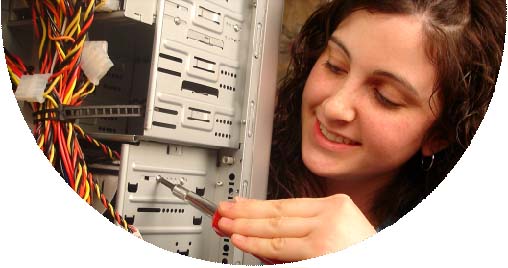by Paul Howard (NCTCUG)
Build Your Own Computer !!
NCTCUG and Intel® will be jointly sponsoring a "Build-Your-Own PC - Part1" seminar, to be held at Carlin Hall on November 2nd at 7 PM. If you've ever wanted to build your own PC to save money, get more bang for your buck, customize a PC, or just learn what goes into the making of a PC, then you won't want to miss this free seminar. Attendees will be provided information on the process and will be given the opportunity to join NCTCUG in order to take advantage of special component prices available only to participants in a special "Build-Your-Own PC - Part 2" workshop to be held on November 23rd, and December 7th . Details will be announced at the seminar, and in emails to members and friends.
The same "Build Your Own PC" seminars will be offered by our sister group, WACUG, on November 19th, 12:30 -3:30 PM, at Micro Center, Fairfax, and on December 10th, at the Fairfax County Government Center. Our hope is that members of either group with scheduling conflicts will have multiple opportunities to attend these meetings with identical presentations.
Details on the seminars and a series of FAQs are available on the web site at: http://www.nctcug.org/byocomputer.html. Those building computers at the "Part 1" sessions must be members of NCTCUG or WACUG, and must have signed the disclaimer form available on the web page noted above, and must turn it in at the build session. Information on the available computer parts kits and the order process is available at: http://www.pcclub.com/byo/
Members ordering the component kits should have them sent to their home. At the time of this writing, neither group has been able to arrange receipt, storage and transportation of the kits to the meeting places, other than by individual participant.
"I shoulda stood in bed!"
An expression my dad used, I suspect borrowed from a thirties radio program, for "one of those days" when something always seems to go awry. Technology's been biting me regularly of late, making me want to throw the covers over my head and hide for a day or three.
In my last column, I discussed the installation of an ATI TV Wonder Pro Card in my computer. I was enjoying watching the TV news in a small window on my computer as I worked on my email. All was fine for a while, and then - it stopped talking! The picture was fine, but the sound output was gone. Well, not entirely - I'd get sound for about four seconds when I clicked on the TV application icon. As soon as the TV picture popped up in the window, the sound would disappear.
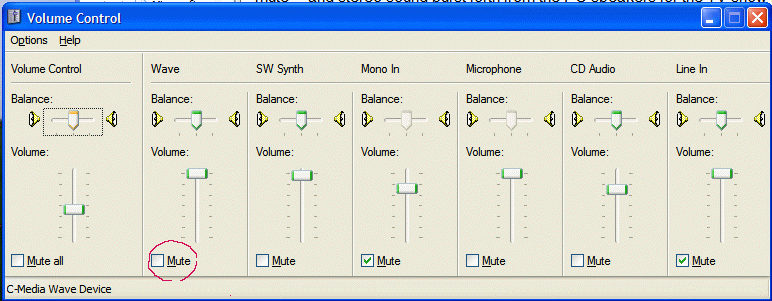
I finally found that double clicking the speaker in the system tray would bring up the "big" volume control panel, not just the single slider volume control of one mouse click. The "wave" slider had a check in the "mute" box - a click to uncheck "mute" - and stereo sound burst forth from the PC speakers for the TV show in question. Roger Fujii suggested that some of the TV applications were notoriously flakey, and that perhaps an option to mute the sound was set when I'd shut down the PC with the sound muted. Now I make sure to exit the TV application only when the sound is blasting loud and clear.
 Back in the days before there were PCs to occupy all my spare time, my primary hobby was repairing TV sets. After a few forgetful incidents when I left my soldering iron plugged in for several days at a time, I ran all the power for my workbench through a master switch. An electrical box held the switch, and a pilot light with a big red plastic jewel. The pilot light's glow was real hard to miss when the overhead lights were turned off - so no more left on test equipment or soldering irons.
Back in the days before there were PCs to occupy all my spare time, my primary hobby was repairing TV sets. After a few forgetful incidents when I left my soldering iron plugged in for several days at a time, I ran all the power for my workbench through a master switch. An electrical box held the switch, and a pilot light with a big red plastic jewel. The pilot light's glow was real hard to miss when the overhead lights were turned off - so no more left on test equipment or soldering irons.Several weeks ago, the pilot lamp finally burned out after 30 years' use, and I picked up a package of two at Lowe's. I screwed in the new bulb, and "flash".. I thought lightning had struck. Examining the package, I discovered it read "12" volts, not "120" - the bulb's innards vaporized so thoroughly they look like mercury on the inside of the glass.
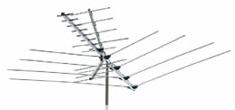 Somewhere, I've read a statistic that only 15% of the US population still get their TV reception over the air from TV stations' transmitters, with the majority opting instead for cable, satellite, and soon - fiber optics, when Verizon's FIOS goes beyond high speed internet and provides television services. Well, I'm in that 15 percent, using a couple of Radio Shack antennas in our garage attic and an amplified "Master Antenna TV" (MATV) system, using coax cable to distribute signals to five TVs and my computer video card.
Somewhere, I've read a statistic that only 15% of the US population still get their TV reception over the air from TV stations' transmitters, with the majority opting instead for cable, satellite, and soon - fiber optics, when Verizon's FIOS goes beyond high speed internet and provides television services. Well, I'm in that 15 percent, using a couple of Radio Shack antennas in our garage attic and an amplified "Master Antenna TV" (MATV) system, using coax cable to distribute signals to five TVs and my computer video card.Some time ago, I started having trouble with UHF reception, which seemed to start when WMPT-22, in Bowie, changed their antenna system for broadcasting HDTV. Linda and I are big fans of the "International Mystery" series that runs on WNVT / MHZ-56, and I even added a UHF-only antenna to our MATV system to try and improve reception. After all, we needed to feed our craving for cop shows from Italy, Germany, France, Sweden, Australia, and the UK!
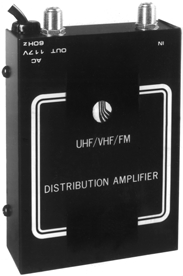
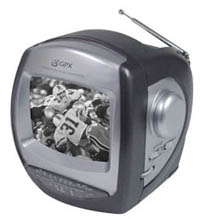 From June on, our TV reception deteriorated on VHF stations also, from about 6 to 9 PM, and I thought all the stations must be getting ready for the HDTV changeover. I was really getting annoyed when I couldn't watch much of the Hurricane Katrina coverage with a decent picture. One evening the sound on WETA-26 got so bad, I pulled out my battery operated emergency TV / Radio - and discovered it got a decent picture and perfect sound, not only for ch.26, but others as well. Finally, I called Ron Schmidt, the only other "no cable" person I know, and had him check his reception. No problems in Maryland quickly pointed to my 22 year-old MATV signal amplifier.
From June on, our TV reception deteriorated on VHF stations also, from about 6 to 9 PM, and I thought all the stations must be getting ready for the HDTV changeover. I was really getting annoyed when I couldn't watch much of the Hurricane Katrina coverage with a decent picture. One evening the sound on WETA-26 got so bad, I pulled out my battery operated emergency TV / Radio - and discovered it got a decent picture and perfect sound, not only for ch.26, but others as well. Finally, I called Ron Schmidt, the only other "no cable" person I know, and had him check his reception. No problems in Maryland quickly pointed to my 22 year-old MATV signal amplifier.I jumped on the internet and ordered a new amplifier. No more problems with signal from 6 - 9 PM. And, while doing some wiring re-arrangements, I ran coax from the antenna to the old amplifier, directly to a TV. I discovered that when I disconnected the old amplifier from AC power, the TV signal on UHF stations actually improved - proof positive! Time to consign that piece of electronics to the scrap heap. So, we've got good TV reception, just in time for the new season. This year, another "vast wasteland" of ghosts, alien invasions, and more awful "reality TV." But I'll confess - I'm curious to see the remake of the '70s Darren McGavin vehicle, "The Night Stalker" - as long as they don't run around cutting people up with chain saws!
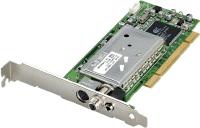
Keeping Up
August 05by Paul Howard (NCTCUG)
PC Television
So, have you run out of tech toys to install in your computer? I've always been interested in the possibility of installing a TV tuner card in one of my computers, and a recent sale at CompUSA seemed like an ideal opportunity. I bought an ATI TV Wonder Pro Card with an RF remote control that plugs in to a USB port, for $70 after rebate.
For years, I've had to turn my head 120 degrees to see the 10 inch TV in my computer room, if I'm trying to do something at the computer. Yup, it's inconvenient and leads to a very stiff neck. My goal was to be able to have a window on the screen with a TV program (usually news), so I could work on my computer project, while keeping up with news events, and switching attention as needed.
Installation was easy - install software from a CD, then turn off the computer, open it up, and install the card in a spare PCI slot. The card does require an amplified TV signal, so you need to have cable, satellite dish service, or an amplified antenna. I'm an "over the air" guy, so the toughest part of the project was getting my TV coax wiring network extended to where I needed it at my computer desk. And, of course, no readily made up 30 foot cables were available, so I had to resort to a splicing connector to get the necessary length to run from the amplifier location to my desk.
The only glitch was getting sound - a connection between the TV card (sound out) and motherboard sound connection (line In) is the recommended approach. I made the connection but couldn't seem to get any sound output, whether I tried the Line In, or Microphone connector. I fiddled with various options for the TV card, and on the various volume control popup windows, but didn't seem to find the answer. Finally, I found an obscure program for the motherboard-based sound circuitry, and managed to change an option which converted the Line and Microphone inputs into outputs for 5.1 channel sound, reversed this, and ‘voila - TV sound came pouring through my speakers. I've spent 20 minutes while writing this, trying to locate that program again, but... no luck.
The TV card has myriad features, including digital VCR recording, frame capture, closed captioning display, zoom in and out, stereo audio, and can even make TV video the background of your screen - a "ghostly" feature that could scare the pants off you if you didn't know it was available. Software is included for the Guide Plus+ interactive program guide, allowing program schedules to be downloaded from the net, and used to set up recording times, as well as program selection for viewing.
Identity Theft
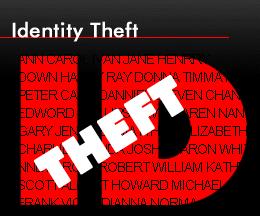 ID theft is a huge topic in the news these days, and a popular subject in many of the magazines around my house, with a major article in July's Money magazine. Consumer Reports for August has a feature on credit scoring, describing a system developed by Fair Isaac and Company to judge applicant credit worthiness. The system, commonly referred to as FICO, is used by the three primary consumer credit reporting bureaus, TransUnion, Experian, and Equifax. The two topics tie together, since a case of identity theft is likely to have a devastating effective on your credit score, if the bad guys open accounts in your name, run up big charges, and then leave merchants or credit card companies whistling for their money.
ID theft is a huge topic in the news these days, and a popular subject in many of the magazines around my house, with a major article in July's Money magazine. Consumer Reports for August has a feature on credit scoring, describing a system developed by Fair Isaac and Company to judge applicant credit worthiness. The system, commonly referred to as FICO, is used by the three primary consumer credit reporting bureaus, TransUnion, Experian, and Equifax. The two topics tie together, since a case of identity theft is likely to have a devastating effective on your credit score, if the bad guys open accounts in your name, run up big charges, and then leave merchants or credit card companies whistling for their money.Consumer Reports (CR) recommends getting a credit report from each of the reporting agencies once a year, and checking FICO scores several months prior to applying for a loan. New Federal legislation passed in 2003 requires the credit bureaus to provide free annual reports, a process being phased in west to east across the country, reaching us on the east coast in September. The web site for providing these reports is run by the three bureaus, and is not winning prizes for ease of use. CR recommends requesting all three reports by clicking on all of them at once, so you don't have to fill out the extensive questionnaire three times. The site is: http://www.annualcreditreport.com.
CR pointed me to the http://www.myfico.com site run by Fair Isaacs, which allows you to purchase all three credit bureau reports, along with their individual FICO scores, for $44.85, or individually for $14.95.
Reviewing the credit reports I obtained was like a blast from the past, with one showing my employer as a job I last worked in June of 1972. It did have all our previous residences correct. One of the reports showed a previous residence as an apparent corruption of our street address coupled with the current proper post office; and with our current address having proper street address, and the old designation for the post office area we live in.
The credit account sections showed a gasoline credit card we've had since I got out of the Army, and the Sears account we've also maintained through the years. Some of the other accounts shown in the credit reports, long since dormant or dropped by us, were hard to figure out because of the many consolidations of the banking industry. It may have been the ABC bank when we used the account, but it's now XYZ - go figure !!
If you decide you need to monitor your credit accounts, CR warns careful shopping, as you might expect. One of the bureaus will sell you a $144 offering that reports daily credit report activity. I saw a package at myfico.com that seemed to cover the bases pretty thoroughly for about $50, and provides one full report from a bureau each quarter. Seems strange that caveat emptor applies to the credit bureau product line, too!
The Obligatory Warning
Jim Brueggeman reports, "Just wanted all to know how important it is to back up files! Thursday morning I walked up to my computer and I had the "blue screen of death" facing me. My C-drive had failed overnight. I was able to replace it and restore all of my programs. My last back-up was at 2 AM Tuesday morning and I had not changed anything on the C-drive since then. I keep my data on a different drive and it wasn't affected. All is well. I'm sure glad my laptop was available during this period. I don't believe I lost anything except money and time!"
Keeping Up May 2005
Paul Howard (NCTCUG)
Software Upgrades
It’s the season for updating. About this time of year, when it’s time to buy tax software, I usually take advantages of the offers for low or no cost upgrades to my antivirus software. This year I got snookered when I went to Office Depot - lots of tax software, but the combination of Norton Antivirus (NAV) and firewall software packages I desired weren’t available. My option was paying for them, leaving my phone number, and hoping they’d call me when their stock arrived.
 As a result, I’ve been getting things in dribs and drabs, and couldn’t find the “3 pack” of Norton Antivirus software I wanted before I had to update (read “pay $24.95 online”) the AV definitions subscription on my backup desktop system. Needless to say, the “3 pack” came available, and on sale for $20 after rebates, a week later. That will give me a spare installation of NAV, should I acquire another computer over the next year.
As a result, I’ve been getting things in dribs and drabs, and couldn’t find the “3 pack” of Norton Antivirus software I wanted before I had to update (read “pay $24.95 online”) the AV definitions subscription on my backup desktop system. Needless to say, the “3 pack” came available, and on sale for $20 after rebates, a week later. That will give me a spare installation of NAV, should I acquire another computer over the next year.In the interim, I bought a copy of Norton SystemWorks 2005, which includes NAV, Norton Utilities, GoBack, Checkit Diagnostics, and System Optimizer. Reviewing the manual before installation, (What a concept!) I saw that one of the steps was a system scan for viruses. I chose instead to make sure my current NAV installation was updated with the latest definitions, and ran a scan, knowing that any definition files on the installation CD would be months old (in fact, dated to August, ‘04).
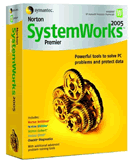 After completing the installation of the SystemWorks software, checking the “Live Update” feature revealed the need for nearly 9 megs of update downloads. Being “Mr. Dialup,” I let the download proceed while watching TV, and then did another scan of the system to eliminate the annoying flag on the status screen chastising me for not having done a complete scan of the system.
After completing the installation of the SystemWorks software, checking the “Live Update” feature revealed the need for nearly 9 megs of update downloads. Being “Mr. Dialup,” I let the download proceed while watching TV, and then did another scan of the system to eliminate the annoying flag on the status screen chastising me for not having done a complete scan of the system.When I started to use the features of the software, I noticed that some of the options were “grayed out” and not available for use. Searching the manual, I discovered that System Information, CleanSweep, System Doctor, Optimization Wizard, Registry Editor, Registry Tracker and others are not installed in a “standard” installation. I hadn’t noticed a “custom installation” option, which is what I usually use when installing software.
The manual advises using Windows XP’s “Add or Remove Programs” feature to install the missing items, and I pointed “Add / Remove” at the CD. A Norton window appeared, with Remove and Modify choices, and I selected Modify. The resulting window showed Antivirus, Utilities, and two other choices, with check boxes and checkmarks. Thinking they were already installed, I unchecked the boxes, and clicked “Next”.
The rest is hazy and painful - suffice it to say I uninstalled those programs that were already on my system. I had to get back to the same place, ten minutes later after the uninstall completed, recheck the boxes, and click on the “Customize Norton Utilities” box, where appeared all the programs I wanted access to when I started this exercise. Making sure they were all checked, clicking “Next” got everything installed, or reinstalled. Then I got to download about 3 megs of updates I’d uninstalled with my faulty assumption, and I got to re-scan the hard drive for viruses - again !!
Video Upgrades
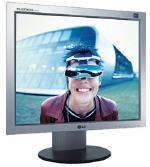 In February 1995, I bought my first Pentium system, and part of the over four thousand dollar package was a 17" CTX monitor that sold for $685. In September of ‘98, the monitor needed a $120 repair, but I continued to use it through two more powerful CPU system replacements. Finally, in February of this year, I decided it was time to move up to a larger monitor. A sale at MicroCenter featured an LG Flatron L1930B for $430 (after $150 in rebates), a monitor that got fairly good ratings from PCWorld for 19"flat panels. Needless to say, April brought a review of ten newer models, but I’m happy with my purchase.
In February 1995, I bought my first Pentium system, and part of the over four thousand dollar package was a 17" CTX monitor that sold for $685. In September of ‘98, the monitor needed a $120 repair, but I continued to use it through two more powerful CPU system replacements. Finally, in February of this year, I decided it was time to move up to a larger monitor. A sale at MicroCenter featured an LG Flatron L1930B for $430 (after $150 in rebates), a monitor that got fairly good ratings from PCWorld for 19"flat panels. Needless to say, April brought a review of ten newer models, but I’m happy with my purchase.I bought a PowerSpec Radeon 9250SE video card ($53) with the monitor, because my existing MSI card didn’t have a DVI interface. The new card also has 128 MB of onboard memory, vs. 64 Megs on the existing MSI board. However, when I got the new display home, I didn’t have the time or inclination to do all the dismantling necessary to put in the new card. So, I just hooked up the analog cable supplied with the monitor (connectors on both ends) and fired up the monitor, which worked great right out of the box.
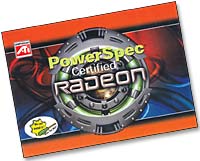 Several days later, I moved the phone, CDs, calculator, bull and bear toys to remind me of the vagaries of the market, keyboard, trackball, assorted pens and pencils and hoisted the computer tower to desktop level. First however, I had to uninstall the video drivers from the computer, thanks to a set of instructions from user group colleague Chuck Roberts, who recently had to replace a video card. I had to work thru the process twice, because the drivers that came with my original card only went down to 800x600, and the grand design is to get down to generic windows drivers at 640x480, before installing the new video card.
Several days later, I moved the phone, CDs, calculator, bull and bear toys to remind me of the vagaries of the market, keyboard, trackball, assorted pens and pencils and hoisted the computer tower to desktop level. First however, I had to uninstall the video drivers from the computer, thanks to a set of instructions from user group colleague Chuck Roberts, who recently had to replace a video card. I had to work thru the process twice, because the drivers that came with my original card only went down to 800x600, and the grand design is to get down to generic windows drivers at 640x480, before installing the new video card.The toughest part of the new installation wasn’t getting the new card in the computer. Weaving the new DVI video cable through the base of the new monitor and getting it plugged in the appropriate jack proved a challenge, with stiff cables having to make right angle turns in limited space. One of the pluses in the PC World review of this monitor was the clean lines it has for desk use where the back of the monitor is visible.
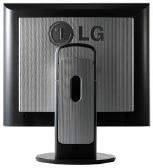 Not having a bank officer’s desk, with the monitor back visible to the public, wasn’t a big seller for me - but I can confirm it swivels nicely if you need to show something to others sitting nearby. That’s apparently a big deal, ‘cause the replacement LG model has autopivot, automirror software that allows image to change so you can flip it over to display to people on the other side of your desk. “Yessir, our friendly loan rate is a mere three percent per month, compounded daily!”
Not having a bank officer’s desk, with the monitor back visible to the public, wasn’t a big seller for me - but I can confirm it swivels nicely if you need to show something to others sitting nearby. That’s apparently a big deal, ‘cause the replacement LG model has autopivot, automirror software that allows image to change so you can flip it over to display to people on the other side of your desk. “Yessir, our friendly loan rate is a mere three percent per month, compounded daily!”I got everything hooked up, turned on the computer, and gasp, blackness. I checked cables, cycled the computer on and off several times, made sure the new video card was properly seated in the AGP slot. Finally, turned the monitor on and off (the right answer’s always last!) and lo and behold, a picture. Apparently, the monitor was still looking for an analog signal, and ignored the digital one. Several times since, the same thing occurred, but all’s been well for the last two weeks.
I popped a DVD movie in the appropriate drive - heaven!! I swear I could see individual raindrops in the movie. The flat panel image was so bright that I’ve reduced it to 80 percent, to avoid wearing sunglasses. On the other hand, perhaps I should wear the shades and the tropical print shirts I bought last year - for the ultimate “cool geek” image <grin>!!
Keeping Up Feb. 05
by Paul Howard (NCTCUG)
New Year - again!! It seems like I just got used to saying and writing “2004." Now I’ve got to remember “2005" - could it be age that’s the problem here? One of my email correspondents recently concluded a message with “You have to grow old, you don’t have to grow up!”
 Well, I won’t beat the dead horse about New Year’s resolutions to back up your vital computer data this year, since I know you took my last plea to do that to heart. Instead, I’ll remind you of the necessity for adding spyware protection to your computer’s arsenal against malefactors. For example, at our last NCTCUG meeting of 2004, we updated Lavasoft’s Ad-Aware SE to a newly introduced version on the group’s demo system, as well as downloading new virus definitions for AVG Anti-Virus.
Well, I won’t beat the dead horse about New Year’s resolutions to back up your vital computer data this year, since I know you took my last plea to do that to heart. Instead, I’ll remind you of the necessity for adding spyware protection to your computer’s arsenal against malefactors. For example, at our last NCTCUG meeting of 2004, we updated Lavasoft’s Ad-Aware SE to a newly introduced version on the group’s demo system, as well as downloading new virus definitions for AVG Anti-Virus.  I fortify my home system with Spyware Blaster, Spybot Search and Destroy, and Ad-Aware. My choice is Norton Internet Security for firewall and anti-virus protection. The key is updating the definition files for protection programs, and being sure the scans are run. Automatic updating and scheduled scans are features of most of these programs. However, I believe in the “belt and suspenders” approach, and take time each week where I manually check for the latest updates and run a scan. I find that particularly necessary for my backup computer and laptop, which don’t get as much use as my primary machine. You can find links to a wide variety of computer protection resources on our web site, at: http://www.nctcug.org/protection.html
I fortify my home system with Spyware Blaster, Spybot Search and Destroy, and Ad-Aware. My choice is Norton Internet Security for firewall and anti-virus protection. The key is updating the definition files for protection programs, and being sure the scans are run. Automatic updating and scheduled scans are features of most of these programs. However, I believe in the “belt and suspenders” approach, and take time each week where I manually check for the latest updates and run a scan. I find that particularly necessary for my backup computer and laptop, which don’t get as much use as my primary machine. You can find links to a wide variety of computer protection resources on our web site, at: http://www.nctcug.org/protection.html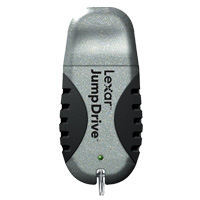 “Thumb” or “keychain” drives - flash memory devices with an integral USB connector that plugs into your PC - are proving to be a great resource for sharing files. We heartily recommend you invest in one or more, and bring them along to NCTCUG meetings, so we can share useful freeware and shareware programs. Thumb drives are an easy way to transfer files between computers, provided both have USB ports.
“Thumb” or “keychain” drives - flash memory devices with an integral USB connector that plugs into your PC - are proving to be a great resource for sharing files. We heartily recommend you invest in one or more, and bring them along to NCTCUG meetings, so we can share useful freeware and shareware programs. Thumb drives are an easy way to transfer files between computers, provided both have USB ports.Windows 98 users will need USB driver software, usually included with the thumb drive on a CD or available for download from the web. XP users should find true “plug and play” functionality - the computer will recognize the drive when it’s plugged into a USB port. Copying files is a simple matter of “drag and drop.”
Member Jorn Dakin advises care if your USB port is on the front of the computer near the floor - apparently an “ask me how I know” moment. Rampaging shoes and thumb drives are incompatible. We suggest plugging in a USB hub to a port on the rear of the machine, and locate the hub on top of your machine or desk. You may need a powered hub if your USB devices get significant power from the USB port - some scanners, printers, and external optical drives, for example.
 Ron Schmidt introduced me to a magazine I’m finding fascinating, “American Heritage of Invention and Technology.” The Fall issue of this quarterly includes an article on the introduction of the first transistor radio, fifty years ago. Finding components to fit in a shirt pocket case, let alone increase the yield of functioning transistors to commercial quantities was a challenging project in the ‘50s - now we have multiple millions of transistors in our computers’ CPUs and memory chips. Other articles of interest in that issue included topics of Colt’s revolver, the loss and recovery of four hydrogen bombs over Spain after a crash of a B-52 and KC-135 tanker, tunnel boring machines, insect traps, and the development of the GPS system. http://www.inventionandtechnology.com/
Ron Schmidt introduced me to a magazine I’m finding fascinating, “American Heritage of Invention and Technology.” The Fall issue of this quarterly includes an article on the introduction of the first transistor radio, fifty years ago. Finding components to fit in a shirt pocket case, let alone increase the yield of functioning transistors to commercial quantities was a challenging project in the ‘50s - now we have multiple millions of transistors in our computers’ CPUs and memory chips. Other articles of interest in that issue included topics of Colt’s revolver, the loss and recovery of four hydrogen bombs over Spain after a crash of a B-52 and KC-135 tanker, tunnel boring machines, insect traps, and the development of the GPS system. http://www.inventionandtechnology.com/One of my “round tuit” projects this year will be putting up a web site in attempt to get back in touch with old friends from college radio station days. Santa brought me a Konica Minolta Dimage Scan Dual IV - a slide scanner. I’ve got several boxes of slides from that era, and until getting the scanner, had no way to add those images to the web site. But, along with the tool, one needs know-how. Scanning the slides is going to take real work - the supplied software has lots of settings for scanning resolution in and out, as well as image correction features. Here we go - scampering up the learning curve again !! The package also includes a copy of Photoshop Elements version 2.
